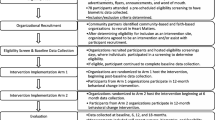Abstract
American Indian and Alaska Native (AI/AN) populations bear a heavy burden of cardiovascular disease (CVD), and they have the highest rates of risk factors for CVD, such as cigarette smoking, obesity, and diabetes, of any U.S. population group. Yet, few randomized controlled trials have been launched to test potential preventive interventions in Indian Country. Five randomized controlled trials were initiated recently in AI/AN communities to test the effectiveness of interventions targeting adults and/or children to promote healthy behaviors that are known to impact biological CVD risk factors. This article provides a context for and an overview of these five trials. The high burden of CVD among AI/AN populations will worsen unless behaviors and lifestyles affecting CVD risk can be modified. These five trials, if successful, represent a starting point in addressing these significant health disparities.
Similar content being viewed by others
References
Baschetti, R. (1998). Diabetes epidemic in newly westernized populations: Is it due to thrifty genes or to genetically unknown foods? Journal of the Royal Society of Medicine, 91, 622–625.
Bradley, P. J. (1992). Re: “Decline in incidence of epidemic glucose intolerance in Nauruans: Implications for the ‘thrifty genotype’”. American Journal of Epidemiology, 136, 499–500.
Caballero, B., Clay, T., Davis, S. M., Ethelbah, B., Holy Rock, B., Lohman, T., et al. (2003). Pathways: A school-based, randomized controlled trial for the prevention of obesity in American Indian schoolchildren. American Journal of Clinical Nutrition, 78, 1030–1038.
Cobb, N., Wingo, P. A., & Edwards, B. K. (2008). Introduction to the supplement on cancer in the American Indian and Alaska native populations in the United States. Cancer, 113(5 Suppl), 1113–1116.
Daley, C. M., James, A. S., Barnoskie, R. S., Segraves, M., Schupbach, R., & Choi, W. S. (2006). “Tobacco has a purpose, not just a past”: Feasibility of developing a culturally appropriate smoking cessation program for a pan-tribal native population. Medical Anthropology Quarterly, 20, 421–440.
Doolan, D. M., & Froelicher, E. S. (2006). Efficacy of smoking cessation interventions among special populations: Review of the literature from 2000 to 2005. Nursing Research, 55(4 Suppl), S29–S37.
Dowse, G., & Zimmet, P. (1993). The thrifty genotype in non-insulin dependent diabetes. The hypothesis survives. British Medical Journal, 306, 532–533.
Goldberg, H. I., Lessler, D. S., Mertens, K., Eytan, T. A., & Cheadle, A. D. (2004). Self-management support in a web-based medical record: A pilot randomized controlled trial. Joint Commission Journal on Quality and Patient Safety, 30(629–635), 589.
Hodge, F. S. (2002). American Indian and Alaska Native teen cigarette smoking: A review. In National Cancer Institute (Ed.), Changing Adolescent and Smoking Prevalence (Monograph 14, pp. 255–261). Bethesda, MD: National Cancer Institute.
Hodge, F. S., & Casken, J. (1999). Characteristics of American Indian women cigarette smokers: Prevalence and cessation rates. Health Care for Women International, 20, 455–469.
Howard, B. V., Lee, E. T., Cowan, L. D., Devereux, D. B., Galloway, J. M., Go, O. T., et al. (1999). Rising tide of cardiovascular disease in American Indians. The Strong Heart Study. Circulation, 99, 2389–2395.
Indian Health Service, U.S. Department of Health and Human Services. (1999). Trends in Indian Health 1998–1999. Retrieved from http://www.ihs.gov/publicinfo/publications/trends98/front.pdf.
Lawrence, D., Graber, J. E., Mills, S. L., Meissner, H. I., & Warnecke, R. (2003). Smoking cessation interventions in U.S. racial/ethnic populations: An assessment of the literature. Preventive Medicine, 36, 204–216.
Lee, E. T., Cowan, L. D., Howard, W. J., Sievers, M. L., Welty, T. K., Wang, W., et al. (1998). All-cause mortality and cardiovascular disease mortality in three American Indian populations, aged 45–74 years, 1984–1988. The Strong Heart Study. American Journal of Epidemiology, 147, 995–1008.
Lee, E. T., Welty, T. K., Cowan, L. D., Wang, W., Rhoades, D. A., Devereux, R., et al. (2002). Incidence of diabetes in American Indians of three geographic areas: The Strong Heart Study. Diabetes Care, 25, 49–54.
Manson, S. M., Jiang, L., Zhang, L., Beals, J., Acton, K. J., Roubideaux, Y., et al. (2011). Special diabetes program for Indians: Retention in cardiovascular risk reduction. Gerontologist, 51(Suppl 1), S21–S32.
National Institutes of Health. Community Responsive Interventions to Reduce Cardiovascular Risk in American Indians and Alaska Natives, RFA-HL-04-023, NIH Guide, Retrieved from 30 Apr 2004. http://grants.nih.gov/grants/guide/rfa-files/RFA-HL-04-023.html.
National Institutes of Health. Community responsive interventions to reduce cardiovascular risk in American Indians and Alaska natives, RFA-HL-06-002, NIH Guide, Retrieved from 9 Dec 2005. http://grants.nih.gov/grants/guide/rfa-files/RFA-HL-06-002.html.
Neel, J. V. (1962). Diabetes mellitus: a “thrifty” genotype rendered detrimental by “progress”? American Journal of Human Genetics, 14, 353–362.
O’Dea, K. (1992). Diabetes in Australian aborigines: Impact of the western diet and life style. Journal of Internal Medicine, 232, 103–117.
Ozanne, S. E., & Hales, C. N. (1998). Thrifty yes, genetic no. Diabetologia, 41, 485–487.
Rollnick, S., Miller, W. R., & Butler, C. C. (2008). Motivational interviewing in health care: Helping patients change behavior. New York, NY: The Guilford Press.
Struthers, R., & Hodge, F. S. (2004). Sacred tobacco use in Ojibwe communities. Journal of Holistic Nursing, 22, 209–225.
Swinburn, B. A. (1996). The thrifty genotype hypothesis: How does it look after 30 years? Diabetic Medicine, 13, 695–699.
Teufel-Shone, N. I., Fitzgerald, C., Teufel-Shone, L., & Gamber, M. (2009). Systematic review of physical activity interventions implemented with American Indian and Alaska native populations in the United States and Canada. American Journal of Health Promotion, 23, S8–S32.
U.S. Census Bureau. (2003). 2000 Census of Population and Housing, Characteristics of American Indians and Alaska Natives by Tribe and Language: 2000. PHC-5. Washington, DC: U.S. Census Bureau.
Acknowledgments
These trials were supported by 5 cooperative agreements between the funding agency and the institutions of the principal investigators. The authors thank the community partners who collaborated in these trials.
Author information
Authors and Affiliations
Corresponding author
Rights and permissions
About this article
Cite this article
Jobe, J.B., Adams, A.K., Henderson, J.A. et al. Community-Responsive Interventions to Reduce Cardiovascular Risk in American Indians. J Primary Prevent 33, 153–159 (2012). https://doi.org/10.1007/s10935-012-0277-9
Published:
Issue Date:
DOI: https://doi.org/10.1007/s10935-012-0277-9




